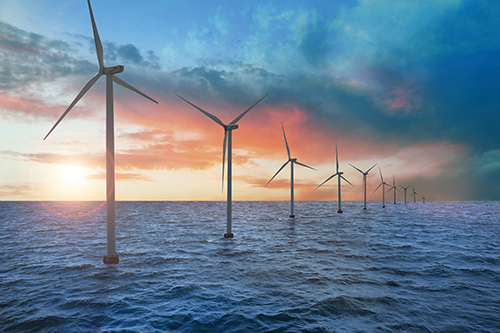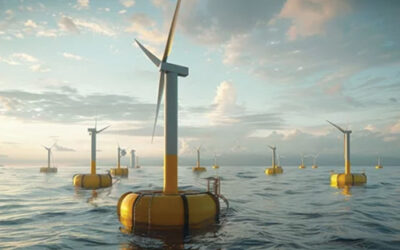With California blowing ahead with gale force-speed into offshore wind energy, the Morro Bay City Council has asked to be kept abreast of developments resulting from decisions made far away from here, where the wind energy farms are slated to be installed.
The City Council approved a Resolution (No. 20-23) calling for regular updates from the staff on developments of the offshore wind farms being planned for a patch of ocean about 30 miles off San Simeon.
The 3 gigawatts of electricity that is reportedly going to be produced are tentatively slated to come ashore in Morro Bay and connect with the power grid at the closed Morro Bay Power Plant.
Infrastructure for that connection and for what’s anticipated to be upgrades to some of the harbor facilities to accommodate crew boats and maintenance needs, will have to involve directly the City of Morro Bay.
The three companies that won leases in an auction held last December were: Equinor Wind US, LLC ($130 million for 80,062 acres); Central California Offshore Wind, LLC ($150.3 million for 80,418 acres); and, Invenergy California Offshore, LLC ($145.3 million for 80,418 acres).
The Federal Bureau of Ocean Energy Management (BOEM) also auctioned leases off the Coast of Humboldt County. Those winning bidders were: RWE Offshore Wind Holdings, LLC ($157.7 million for 63,338 acres); and California North Floating, LLC ($173.8 million for 69,031 acres). These two areas are the only ones that the BOEM has identified off California for wind energy development and the agency took in some $757 million for the five leases.
An earlier sale off the Coast of New England brought in over $4.5 billion and BOEM has recently started work on wind lease sites in the Gulf of Mexico. The Biden Administration has set a goal of developing 30 GW of offshore wind energy in the U.S. by 2030.
The council Resolution also authorizes the “Council Sub-Committee on Offshore Wind Energy,” consisting of Mayor Carla Wixom and Councilwoman Zara Landrum, to attend the “Pacific Offshore Wind Summit” set for Monday-Wednesday, May 8-10 in Sacramento. Cost to attend that summit is estimated at $3,200.
Already there have been several developments in the quest to harness the offshore winds of the Pacific starting with September 2021 and Assembly Bill 525 that called for the California Energy Commission “to develop a strategic plan for offshore wind energy developments to be installed off the California Coast in federal waters,” according to the report from Interim City Manager, Greg Carpenter.
That report is due in June to the Natural Resources Agency and State Legislature.
“Among other things,” Carpenter said, “the Strategic Plan will address issues that could potentially impact the City of Morro Bay, including recommendations to upgrade ports and other infrastructure required to support the offshore wind energy; transmission investments and upgrades to deliver offshore wind generated electricity; planning, permitting and potential impacts on coastal resources, fisheries, Native American and Indigenous peoples, as well as strategies for addressing those potential impacts.”
More recently, Carpenter said, a report was released March 29 by the U.S. Department of Energy. The Offshore Wind Energy Strategy is “a comprehensive summary of the Department’s efforts to meet President Biden’s goal to deploy 30 GW of offshore wind energy by 2030 and set the nation on a pathway to 110 GW or more by 2050.”
There are two bills related to offshore wind currently moving through the California State legislature:
• AB 3 — the Offshore Wind Advancement Act, would require studies and reports on seaport readiness for offshore wind energy development and feasibility of achieving 70% and 85% in-state assembly and manufacturing of offshore wind energy projects.
• AB 80 — the Offshore Wind Coastal Protection Act would require the Ocean Protection Council, which establishes policies to coordinate the collection, evaluation, and sharing of scientific data related to coastal and ocean resources among agencies, to establish a West Coast Offshore Wind Science Entity. That agency would ensure that “comprehensive baseline monitoring of the California ocean ecosystem, as well as targeted research are available and used to inform state and federal decisions, as well as state the intent of the California Legislature to enact future legislation to create the Offshore Wind Coastal Compensation Fund.”
That fund, Carpenter said, would be to “mitigate the impacts of the deployment of offshore wind infrastructure in California on the tourism industry, marine and other coastal wildlife, the fishing industry, and other entities, funding costs associated with the future decommissioning of obsolete offshore wind infrastructure, and providing funding to marine life sanctuaries, federally recognized tribes, cities, and counties.”
In all, the Resolution is intended to try and give Morro Bay a “seat at the table” as these massive wind turbines and vast wind farms are put out in the open ocean and California takes a step into the unknown, for while wind turbines have a long history of use around the world, there are currently no “floating” wind turbines installed anywhere.
Offshore wind turbines in use today, mainly in Europe, are installed in shallow waters and imbedded solidly in the seafloor.
Having these turbines floating on the surface of the ocean will require some significant feats of engineering, as the open ocean has many hazardous sea conditions possible that engineers will have to account for.
For the time being, the lease auction winners have embarked on extensive environmental impact studies needed to satisfy both State and Federal environmental laws.
Something that’s sure to come up is impacts on marine mammals, especially whales, as dozens of dead whales and dolphins have washed up on the shores of the East Coast over the past several months.
The die-offs happened while energy companies have been doing sonar mapping of the seafloor as part of the environmental review for offshore wind development, however, to date, no correlation has been announced between the sonar blasts and the dead whales.
The U.S. Fish & Wildlife Service had issued a “Federal Take Permit” that set the allowable number of whales that could be harmed or killed at over 30.
Such a Take Permit will also have to be issued for here though the number of whale deaths that would be deemed acceptable has not yet been set.
With so many spinning plates in the air with offshore wind development, having regular reports and updates to the City Council could be a good way for residents to keep abreast of the developments with this new industry that is headed our way.




